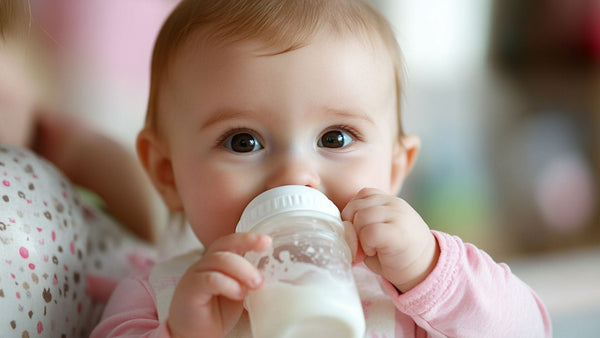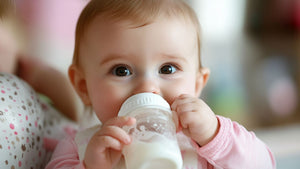Dented Formula Cans & Creased Boxes
51 hours of research 4 minute read

Have you ever received a formula with a dented container or creased box? As a parent, you want the best for your child, and damaged items appear questionable. But don't worry, slight dents and scratches in formula packaging are usually insignificant. Still, there are a few types of damage that you should avoid. Continue reading to learn how to identify harmful cans and boxes so you can feed your baby with confidence. Please note that we also take particular care in packing our formula to keep it fresh for your baby.
Identifying different types of damage
It's important to know the difference between a dented can and an excessively damaged can while dealing with creased or dented cans and boxes. A dented one can still be safe to eat, but one with substantial damage might be unsafe to one's well-being.
When it comes to identifying damage, here are some key features to look for:
Dented Formula Can: A can that has been dented will have a slight dent on one of the container's sides, top, or bottom. The can will still be intact despite the dent, though there might be a little unevenness in the packaging.

Severely Damaged Cans: Containers that have been severely damaged should not be consumed since they might present a risk to one's health. Punctures in the packing, which may cause the formula to leak, are examples of badly damaged containers.

Creased Formula Boxes: If a box has been creased or bent it may still be safe for consumption. However, if there are any signs of punctures or tears that let air inside the silver packaging, it is no longer safe to consume.

What you should know about can dents?
It's natural to be concerned about safety while dealing with dented cans. The good news is that superficial damage is generally not a cause for concern. There are, however, a few points to keep in mind.
Dents in cans are generally not a problem as long as the can is not bulging or leaking. Small dents along the can's rim or sides are unavoidable. Avoid cans with deep dents that affect the seams in a visible way. A broken seal could allow air or contaminants to enter the can. To be safe, throw away severely dented cans which have a broken seal.
Major damage vs. minor denting: How to tell the difference?
When it comes to dented cans, small dents are usually acceptable, but major dents can be harmful. How can you tell the difference?
Minor dents in a can of formula milk can vary in size and appearance, but they typically refer to small imperfections on the surface of the can that do not affect the safety or quality of the product. Here are a few examples of what minor dents in a can of formula milk might look like:
- Small indentation: A shallow concave mark on the can's surface.
- Crease or wrinkle: A narrow, elongated dent that appears as a folded line on the can.
- Dimple: A small, rounded depression on the can, similar to the dimples on a golf ball.
- Surface blemish: A minor imperfection, such as a scratch or scrape, that does not penetrate the can or compromise its integrity.
Samples of Minor Dents:
Dented HiPP Can

Dented Kendamil Can

Dented Kabrita Can

Major damage in a can of formula milk often relate to more substantial abnormalities that could compromise the product's safety or quality. Here are some examples of major dents:
- Punctures or holes: Any spaces in the can that allow air into the formula.
- Tears or rips: Damage that compromises the entire packaging, particularly along seams or edges.
- Bulging or swollen cans: This can indicate spoiled or contaminated formula, which is harmful.
- Rust or dents around seams: This type of damage is more likely to compromise the seal and enable contamination.
Samples of Major Damage:
Crushed HiPP Can

Punctured HiPP Can

Broken Kendamil Can Seam

Box creases and tears: How to tell if your formula is still safe
When it comes to creased or split formula boxes, it's important to determine whether the product inside is still safe for your infant. As a rule of thumb, the formula should be fine if the damage is simply cosmetic and the interior bag is still properly sealed. However, specific types of damage can compromise the formula and cause the product to be discarded.
Inspect the inner packaging: Inspect the inner packaging, such as the foil that holds the formula, carefully. The formula may still be safe to use if the inner package is intact and there are no visible signs of damage.
Check for leaks or contamination: If the packaging has tears or punctures, look for signs of leakage or contamination on the inside. If you observe any moisture or discoloration, it is better to discard the product because it may have been contaminated.
Evaluate the severity of the damage: Consider the size of the creases or tears to determine the degree of the damage. The formula may still be safe to use if the damage is small and does not impair the overall integrity of the packaging or the seal. However, if the damage is severe and compromises the seal or protective layers, the formula should not be used.
Minor creases on the box of formula milk are normally small and have no substantial impact on the packaging's integrity or safety. As long as the inner foil remains in tact, box related damage is considered minor because the contents of the consumable product are not impacted. Here are some minor crease examples:
- Superficial Creases: A shallow and thin line-like crease on the box's surface, usually less than an inch long, but may run the length of the box.
- Surface Wrinkle: A minor indentation or wrinkle on the surface of the box that has no bearing on the overall construction or seal.
- Fold Line: A mild fold or crease along a specific area of the box, usually caused by handling or storage.
- Corner Crease: A slight fold on one of the box's corners does not damage the packaging's protective qualities (i.e. no damage to the inner foil).
- Damp Cardboard: The box shows up wet, and may have dried along the way. This is often caused in the "delivery last mile" when in contact with some rain, and while this may be unpleasant, the inner foil remains undamaged.
Sample of Minor Creases:
Surface Wrinkle

Torn Cardboard

Creased Corners + Dampness

Major damage on a box of milk formula refers to more significant deformities that can have compromised the integrity or safety of the inside packaging. In other words, major damage is considered in the event that the inner foil has had ruptured or suffered a forceful puncture. Here are some examples of major creases:
- Torn or Punctured Area: An inner package tear or puncture that exposes the formula to potential contaminants or undermines the seal.
- Split Foil Seam: The inner packaging's seam is broken or opened, resulting in a considerable space or split that can cause formula leakage or exposure.
Sample of Major Creases:
Punctured Foil

Improperly Sealed Foil

Broken Crease

Dry formula cans are different from 'wet' canned goods!
Dry formula cans, as opposed to traditional canned goods that may contain liquid, are designed to maintain a consistent level of humidity. As a result, dry formula containers have special coatings and finishes to protect the product from moisture and heat.
These protective coatings aid in the reduction of damage caused by everyday dents and creases. This means that typical minor flaws, such as a slight dent or crease, won't compromise the can's integrity or ability to keep the contents safe.
Here are a few reasons why the damage to these canned products may differ:
Consistency and Composition: Powdered milk and wet food are not the same in terms of consistency and composition.
- Powdered milk is a dry and powdery substance. It is not under pressure and is not impacted by dents that haven't punctured the can.
- Wet food is a mixture of solid or semi-solid food items and liquid, and have a minor amount of pressure which can bulge if the can undergoes blunt trauma.
Differences in consistency can affect how they respond to physical stress and damage.
Packaging Design: Canned powdered milk and wet food often come with packaging that is customized to their contents.
- Metal cans and composite containers, for example, can vary in thickness, strength, and damage resistance. These distinctions can lead to differences in the types of damage that occur.
Handling and Storage: The criteria for handling and storage of powdered milk and wet food may differ.
- Powdered milk is more vulnerable to moisture and humidity, which might have an impact on its quality. As long as there is no puncture, the moisture and humidity content is the same as when the product left the manufacturer.
- Wet food may require special temperature management and preservation to avoid deterioration.
These differences can have an impact on the forms of damage that can occur during shipping, storage, or mishandling.
Is it safe to consume a can of formula milk with severe damage?
If the can of formula milk has massive dents with puncture holes, shows air bulges, has visible leaks, or exhibits rust, it may compromise the product's safety and quality.
Since formula milk is intended for infants with less developed immune systems, we do not recommend giving contaminated formula to any baby. Pay attention to the following guidelines:
- Do not use formula milk cans that have noticeable faults of severe damage, such as punctured dents, air bulges, formula leaks, or rust. These may compromise the product's safety.
- Inspect the packaging for any signs of tampering, such as broken or punctured inner seals. If the packaging appears to be tampered with, do not use the formula milk.
- Check the expiration date on the can to be sure it is still within the appropriate time frame. Formula milk that has expired should not be consumed. Bear in mind that European date formats are different to American date formats!
- Even if the packaging appears unbroken, it is important to follow the manufacturer's preparation and storage recommendations to ensure the formula's safety.
Is it safe to consume boxed formula with severe damage?
If the inside foil packaging is greatly damaged in a way that exposes the formula to oxygen, the product should not be consumed. Inside powdered milk packaging, such as foil pouches or bags, provide an additional layer of protection against contamination, moisture, and air. If the interior packaging is damaged, or spoiling, the growth of bacteria, or a leak of hazardous substances may happen.
Here are certain factors to consider:
- Damaged inside packaging can allow bacteria, mold, or other contaminants to enter, posing potential risks if consumed.
- If the inside of the packaging is damaged, moisture may enter the powdered milk, causing clumping, spoiling, or the growth of unsafe bacteria.
- Due to the damaged inner packaging, the powdered milk may be exposed to air, resulting in oxidation and a loss of cleanliness, flavor, and nutritional content.
What makes our packaging different and stronger?
Here are some of the aspects that often contribute to a perception that our packaging is stronger than average:
Strong Materials: Our packaging is made of robust materials that protect the contents better. Cardboard boxes, for example, are specifically chosen of a higher-quality, thicker material, making more resistance to potential damage during shipment or handling.
Packaging for Sustainability: Our packaging systems prioritize sustainable substances and production processes, lowering waste and environmental effects. This commitment to sustainability frequently manifests itself in packaging that is solid and long-lasting.
High Standards: Europe has strict quality standards and regulations in place for packaging materials. These requirements ensure that packaging meets particular criteria for strength, durability, and resistance to environmental influences.
Why do we not use packing peanuts or non-environmentally friendly packaging?
The usage of packing peanuts and other non-eco-friendly packaging materials has various disadvantages, prompting a global shift toward more sustainable alternatives. The following are some of the reasons why these materials are being phased out:
- Packing peanuts, which are frequently constructed of expanded polystyrene (EPS) or other non-biodegradable materials, contribute to pollution and environmental impact. They are difficult to degrade and can remain in the environment for hundreds of years. Their disposal can be difficult, and improper disposal might result in litter or wildlife harm.
- Packaging materials that are not environmentally friendly, such as packing peanuts, contribute to waste generation. They are frequently used to cushion and protect packages during transportation, but once opened, they constitute waste that must be disposed of. This contributes to the total waste stream and landfill burden.
- While there are some biodegradable packing peanut options available in Europe, these are not as readily available as in some other countries and therefore come at very high costs (4-6x higher than petroleum based packing peanuts). If we used these as a packing option, the added costs of these would significantly increase shipping costs for all customers.
Did Organic Life Start ship a dented or damaged formula?
All of our products leave our warehouse in the same perfect condition that we receive from our manufacturers – no dents, creases, or damage.
How come some packages have been damaged or dented?
- Since the package is shipped internationally, it may be inspected by at the border. Officials may open the box and examine it.
- They sometimes repack the cans in a different order than we did.
- A dent may form when the cans inside the box are not properly positioned in the original way that we packaged them at our warehouse.
This is why some cans/boxes may show dents or creased, even when the outside box appears intact. If the cans you received are severely damaged, reach out to us and we will work with you to find a better solution.
Damaged Baby Formula
In conclusion, when it comes to dented cans and creased boxes, it's important to consider the severity of the product's damage. If the can or box only has a minor dent, it is almost always safe to consume. However, if the damage is more serious or the product is leaking, it would be best to discard it. By familiarizing yourself with the various types of damage and their implications, you can make sure that you get the best and safest products for your baby.
Additionally, it's worth noting that if you receive a package with a damaged box, such as a FedEx damaged box, it's crucial to inspect the contents carefully before use to ensure that the products inside remain in proper condition and pose no risks to your baby's health.
Top 3 European Formulas
Organic Life Start is committed to providing accurate, reliable, and trustworthy information to parents and caregivers. We carefully choose credible sources and follow a meticulous fact-checking process to uphold the highest standards in infant nutrition and parenting advice. To learn more about our dedication to accuracy, please explore our editorial guidelines.
Link To Sources







